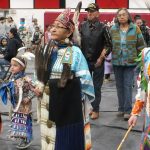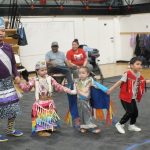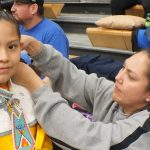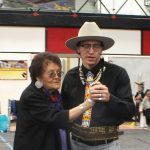At the Blackfeet Early Childhood Center on the Blackfeet Nation about an hour south of the Canadian-U.S. border in Montana, the school’s walls are lined with colorful flyers depicting English literacy, and physical and mental well-being concepts are displayed in both English and the Blackfeet language.
On the health and wellness wall, a medicine wheel of the four directions—the human life cycle with sacred teachings—is written in both English and Blackfeet. The poster below shows family relations solely in the nation’s traditional tongue as seen in a social media post.
The inclusion of Indigenous languages in early education has always been part of the curriculum among the tribes in Montana but now it has been formalized and funded this year with state support to ensure the languages are preserved.
“As we were having meetings with tribal nations, language preservation within early learning settings was a topic that kept coming up,” says Alex DuBois, business and community engagement manager for Zero to Five Montana, a statewide, nonpartisan advocacy nonprofit working to advance early childhood policy strategies. “…There’s been a lot of excitement around tribal language preservation, especially after the Covid-19 pandemic. A lot of elders were lost during that time, especially the ones that were in early learning facilities. They were really the teachers of the tribal language and culture.”
The state has 12 tribes located on seven reservations, and Native Americans make up about 8 percent of Montana’s population. Children under age 5 account for 8 percent of the population on reservations in Montana.
About 167 Indigenous languages are spoken in the U.S., and it’s estimated that only 20 will remain by 2050 if language patterns do not change, according to a Bureau of Indian Affairs report. Many tribal languages have been threatened or lost because of past federal policies forcing tribes into assimilation.
In one assessment of the Chippewa Cree in Montana in 2020, it was revealed that 3 percent of the nearly 650 tribal members surveyed spoke Cree and only one fluent speaker existed, which caused a tribal business group to declare a state of emergency on the reservation. Three other languages, including the Assiniboine, Gros Ventre and Montana Salish, have been listed as critically endangered.
It matters. Studies show that when schools include tribal languages in instruction, students have a stronger sense of identity and have healthier mental and physical outcomes.
Resourcefulness and collaboration have been key in providing a steady revenue stream of funding and support for early education in Montana and tribal language programs. Though Montana is one of four states in the U.S. that does not provide public pre-school, tribes have obtained private foundation resources, public grant, and federal and tribal dollars to fund their early Head Start, Head Start or pre-k programs that included language.
Tribal colleges such as Salish Kootenai and Stone Child have also provided assistance by creating scholarships for Indigenous students to obtain degrees in early childhood education, and to help and encourage the students to continue their education from associate to master degrees to meet state education licensing, tribal or federal Head Start requirements.
Zero to Five Montana also provided legislative support by hiring a tribal policy coordinator and creating an infant-toddler pilot language program. The lessons learned in these pilot programs were integrated into state legislation earlier this year, which included early childhood programs in the state tribal language program. Tribes can now apply for state grants for tribal language preservation to supplement or build upon their early childhood programs.
Montana and Oregon are among U.S. states that provide public funding for early learning programs. New Mexico and Washington provide tribal language funding starting with kindergarten.
Minnetta Armstrong, Blackfeet Early Childhood Center director, has run the program for 47 years. She has seen a positive difference in children when language is integrated into early learning. There are currently about 300 kids enrolled at seven sites across the reservation.
“It’s really a benefit for them because they are using their whole brain, the right and left, and this is the most important part of learning in this age zero to five,” Armstrong said. “It brings back their identity: who they really are and where they come from. It also brings back a sense of worth and self-esteem. Learning the language really changes their behavior.”
Kim Baca (Navajo/Santa Clara Pueblo) is an award-winning writer and owner of KB Consulting, an Albuquerque-based company specializing in public relations, communications and content marketing in mainstream markets and Indian Country. Kim provides services based on nearly 10 years of media experience that includes The Associated Press, The Santa Fe New Mexican and El Paso Times. Kim has also been a marketing and communications director in the higher education and nonprofit sectors, and served as interim executive director of the former Native American Journalists Association before the organization moved to Oklahoma.



















